 A video clip for a Monday. During a practice match against British challenger INEOS Team UK, Peter Burling, Team New Zealand skipper, lost control of the AC75 Te Rehutai during a gybe. While sailing at about 35 knots, the boat took a nose-dive and rolled on its beam ends. Remarkably, there were no reported injuries or significant damage to the boat.
A video clip for a Monday. During a practice match against British challenger INEOS Team UK, Peter Burling, Team New Zealand skipper, lost control of the AC75 Te Rehutai during a gybe. While sailing at about 35 knots, the boat took a nose-dive and rolled on its beam ends. Remarkably, there were no reported injuries or significant damage to the boat.
 Sometimes size matters. We have recently seen ever-larger container ships delivered from Asian shipyards. This year, the HMM Algeciras claimed the title of the world’s largest container ship with a carrying capacity of 24,000 TEUs. It is one of twelve eco-friendly container vessels delivered or under construction at Daewoo Shipbuilding and Marine Engineering in Ulsan, Korea.
Sometimes size matters. We have recently seen ever-larger container ships delivered from Asian shipyards. This year, the HMM Algeciras claimed the title of the world’s largest container ship with a carrying capacity of 24,000 TEUs. It is one of twelve eco-friendly container vessels delivered or under construction at Daewoo Shipbuilding and Marine Engineering in Ulsan, Korea.
Bigger is not always better, of course. The Ultra Large Crude Carrier (ULCC) tanker Seawise Giant, later Knock Nevis, at 565,000 DWT was by many standards just too large. It was too large, for example, to transit the English Channel at a full load. After a long and generally successful career, it was scrapped in 2009 and no tanker has been built as large since.
These thoughts on size were triggered by a new and larger offshore wind turbine design developed by GE. The Haliade-X offshore turbine features a 14 MW, 13 MW, or 12 MW capacity, 220-meter rotor, a 107-meter blade. By comparison, in recent years the average offshore wind turbine capacity has been around 3.6 MW. Relatively newer turbine designs installed off Block Island and off Virginia have used 6 MW turbines, less than half the capacity of the Haliade-X.
Here is a fascinating short video of British riveted steel shipbuilding in the 1940s. The shipyard in the film is the Burntisland Shipbuilding Company in Fife. The ship being built is thought to be either the MV Dalhousie or the SS Ger-y-Bryn. Both ships were sunk by German vessels by April 1943. Thanks to W. H. Bunting for pointing out the video.
Shipbuilding – 1940’s British Council Film Collection – CharlieDeanArchives
 Last October, the Puget Sound Naval Shipyard completed the year-long dismantling of the US Navy nuclear-powered attack submarine USS Narwhal (SSN-671). Commissioned in 1969, the submarine was a one-of-a-kind, an experimental design that would become one of the most successful boats of her era. She was the quietest attack submarine in the U.S. fleet in the 1970s and was routinely deployed to watch Soviet submarines in the Atlantic and around Soviet-supported satellite states in the Mediterranean Sea.
Last October, the Puget Sound Naval Shipyard completed the year-long dismantling of the US Navy nuclear-powered attack submarine USS Narwhal (SSN-671). Commissioned in 1969, the submarine was a one-of-a-kind, an experimental design that would become one of the most successful boats of her era. She was the quietest attack submarine in the U.S. fleet in the 1970s and was routinely deployed to watch Soviet submarines in the Atlantic and around Soviet-supported satellite states in the Mediterranean Sea.
Sound is the enemy of a stealthy submarine. The technologies developed for the Narwhal have helped make US submarines among the quietest in the world’s navies. What made the Narwhal so quiet?
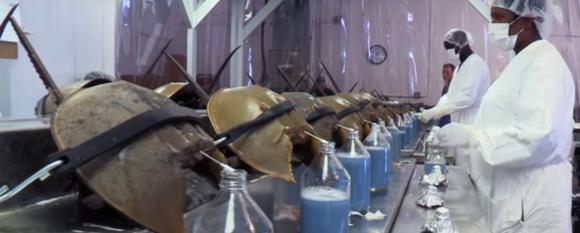 As the race is on to distribute Covid-19 vaccines around the globe, horseshoe crabs, or more specifically, horseshoe crab blood, is playing a major role in ensuring that the vaccines are safe to be injected into peoples’ arms. In fact, horseshoe crab blood plays an important role in the safety of all vaccines, but the surge in demand for Covid-19 vaccines is raising new concerns about potential overharvesting. Here is a repost updated for the pandemic from about a year and a half ago.
As the race is on to distribute Covid-19 vaccines around the globe, horseshoe crabs, or more specifically, horseshoe crab blood, is playing a major role in ensuring that the vaccines are safe to be injected into peoples’ arms. In fact, horseshoe crab blood plays an important role in the safety of all vaccines, but the surge in demand for Covid-19 vaccines is raising new concerns about potential overharvesting. Here is a repost updated for the pandemic from about a year and a half ago.
Horseshoe crabs are an ancient variety of arthropods, which are not actually crabs. Having remained largely unchanged in about 450 million years, the horseshoe crab is considered by many to be a living fossil. One of the reasons that horseshoe crabs have survived so long is that they have a highly robust immune system. Indeed, the horseshoe crab’s bright blue blood has remarkable antibacterial properties.
The good news for humans, and the bad news for horseshoe crabs, is that amebocytes in the horseshoe crab blood are highly sensitive to tiny amounts of bacteria and will coagulate around as little as one part in a trillion of bacterial contamination. Limulus Amebocyte Lysate, or LAL, a compound processed from horseshoe crab blood is used to test for contamination of anything that might go inside the human body: every shot, every IV drip, and every implanted medical device.
 The salvage of the stranded car carrier Golden Ray is accelerating. Salvors on the heavy-lift barge VB-10,000 are using a heavy chain to cut the ship into sections to be carried away by barge. The recently completed the second cut, separating the ship’s stern, which has been lifted onto Barge 455-8 to be hauled away to a recycling facility in Louisiana to be scrapped. On-water response teams recovered oil released from the wreck during lifting operations.
The salvage of the stranded car carrier Golden Ray is accelerating. Salvors on the heavy-lift barge VB-10,000 are using a heavy chain to cut the ship into sections to be carried away by barge. The recently completed the second cut, separating the ship’s stern, which has been lifted onto Barge 455-8 to be hauled away to a recycling facility in Louisiana to be scrapped. On-water response teams recovered oil released from the wreck during lifting operations.
The first cut, which separated the bow of the ship, took approximately three weeks to complete while the second cut took only eight days. There is some concern that now that the bow and stern sections of the ship have been removed, that managing oil and debris from the ship will become more challenging.
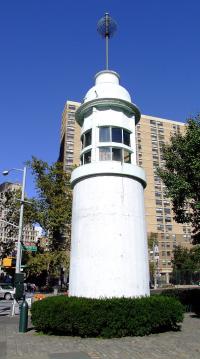 Thanks to Captain Richard Bailey for mentioning the time ball on the Titanic Memorial in the Financial District of downtown New York City. We neglected to mention it in our post “Watching the Ball Drop — the Nautical Origins of a New Year’s Tradition.”
Thanks to Captain Richard Bailey for mentioning the time ball on the Titanic Memorial in the Financial District of downtown New York City. We neglected to mention it in our post “Watching the Ball Drop — the Nautical Origins of a New Year’s Tradition.”
The memorial, a 60-foot tall lighthouse with a time ball on a staff rising above it, feels just slightly of place, as it is largely surrounded by buildings and several blocks from the East River, at the entrance of the South Street Seaport. It has not always been so landlocked, however. There is also a fascinating story behind the memorial.
In 1912, Denver socialite and philanthropist Margaret Brown rushed home from a trip to France on learning that her eldest grandchild was seriously ill. She immediately booked passage on the first available liner leaving for New York, the RMS Titanic.
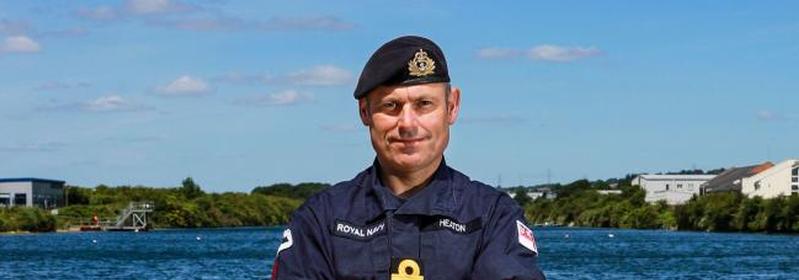 In recognition of his accomplishments and service, Lt Cmdr Sean “Central” Heaton has been made an MBE (Most Excellent Order of the British Empire), in the New Year Honours list.
In recognition of his accomplishments and service, Lt Cmdr Sean “Central” Heaton has been made an MBE (Most Excellent Order of the British Empire), in the New Year Honours list.
World War II had been over for more than 70 years, when in 2018, an unexploded 500-pound Luftwaffe bomb was found on the bottom of London’s King George V Docks – next to London City Airport. The discovery led to the cancellation of all flights to and from the airport, evacuation of more than 100 homes, and closure of the Channel Tunnel and other public services.
The bomb was safely disarmed by a team of Royal Navy experts led by Lt Cmdr Heaton, working side by side with civilian authorities and agencies over a three-day operation.
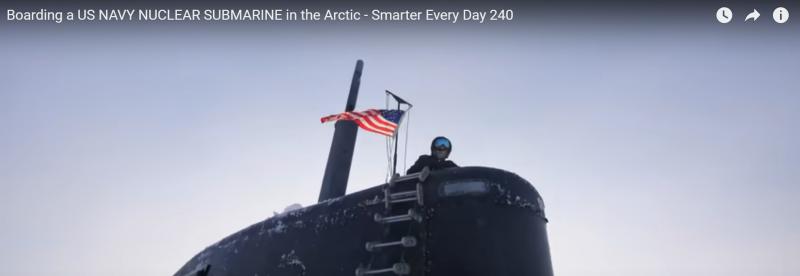 A video for a Sunday afternoon. In March, the US Navy officially commenced Ice Exercise (ICEX) 2020 in the Arctic Ocean with the construction of a temporary ice camp, Camp Seadragon, and the arrival of two US Navy fast-attack submarines.
A video for a Sunday afternoon. In March, the US Navy officially commenced Ice Exercise (ICEX) 2020 in the Arctic Ocean with the construction of a temporary ice camp, Camp Seadragon, and the arrival of two US Navy fast-attack submarines.
Destin Sandlin from the Smarter Every Day Youtube vlog was allowed to go aboard the USS Toledo during ICEX. The video below captures what it is like to board a US Navy fast-attack submarine in the Arctic.
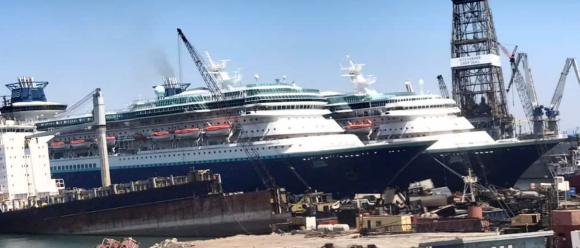
Sovereign and the Monarch in Turkish scrapyard
In early February, outbreaks of the coronavirus began to occur on cruise ships. On one quarantined ship, the Diamond Princess, one infection spread to over 700 cases and seven deaths from COVID-19. In March of 2020, the cruise industry was effectively shut down by a Center for Disease Control (CDC) “No Sail Order.” Recent attempts to restart even limited cruising have not been notably successful.
Not surprisingly, several cruise lines have ceased operations and at least 11 cruise ships have been sent to the scrapyards. Nevertheless, 16 new cruise ships were delivered in 2020, most of which sailed directly to layup. Now in 2021, an additional 30 cruise ships are scheduled to be delivered from shipyards around the world. Incredibly, another 31 ships are scheduled for delivery in 2022.

The USNO Millennium Time Ball
Last night in New York City, people watched, primarily on-line or on television, as a jeweled ball dropped in Times Square at exactly midnight to mark the arrival of the New Year, 2021. In past years, the crowd in Times Square numbered up to a million people. This year, as a result of the pandemic, there were literally only a few dozen people in attendance.
Nevertheless, the ball still dropped at midnight. The six-ton Waterford crystal ball covered in 32,276 LED lights was not actually “dropped” but lowered from a flag pole on the roof of One Times Square. In New York City, the tradition dates back to 1907. But where did the tradition of dropping a ball to mark the time originate? The practice dates back to 1829 and was related to helping sailors calculate their position at sea. Here is an updated repost.
 A few years ago, we posted about the RMS Warrimoo, which is remembered, as the story goes, for crossing the intersection of the international dateline and the equator at precisely the turn of the century from 1899 to 1900. In doing so, the ship was said to be in two different days, two different months, two different seasons, two different years, and also in two different centuries-all at the same time. There may even be some truth to the sea story. Click here to read more.
A few years ago, we posted about the RMS Warrimoo, which is remembered, as the story goes, for crossing the intersection of the international dateline and the equator at precisely the turn of the century from 1899 to 1900. In doing so, the ship was said to be in two different days, two different months, two different seasons, two different years, and also in two different centuries-all at the same time. There may even be some truth to the sea story. Click here to read more.
While the story of the RMS Warrimoo was a once in a century event, Katie Weeman, writing in the Scientific American Observations blog, discusses a well-known spot in the ocean where time itself becomes almost meaningless. Likewise, even the concept of direction gets fuzzy, at best. She is referring, of course, to the North Pole.
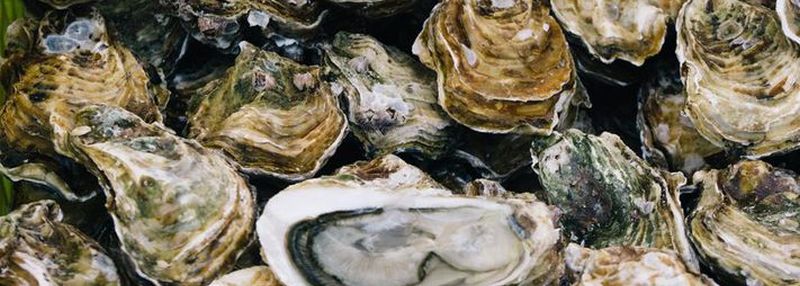 The pandemic has been brutal to the restaurant industry. Likewise, the small-scale oyster growers of Barnegat and Delaware bays have been extremely hard hit as restaurants cut back on their orders or shut down altogether.
The pandemic has been brutal to the restaurant industry. Likewise, the small-scale oyster growers of Barnegat and Delaware bays have been extremely hard hit as restaurants cut back on their orders or shut down altogether.
One bit of good news, however, is a new partnership formed by the Pew Charitable Trusts and The Nature Conservancy, intended to support the oyster industry while also helping to restore damaged and dying reefs in coastal waters.
NJ Spotlight News reports that the initiative, called Supporting Oyster Aquaculture and Restoration (SOAR), has designated $2 million to buy back some 5 million oysters from over 100 oyster farmers in New England, the mid-Atlantic, and Washington state. Once the bivalves are purchased, they are transported back to the water to be “replanted” on existing oyster reefs in need of restoration.
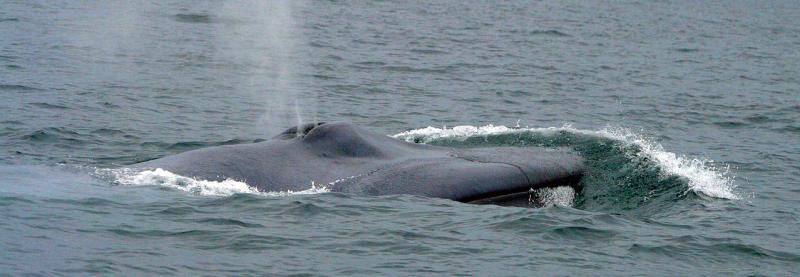 A new blue whale population has been discovered in the Arabian Sea and Western Indian Ocean according to a study recently published in the journal Endangered Species Research. The conclusion is based not on sightings or DNA samples, but rather on recordings of the unique whale songs that distinguish this whale population from other blue whales in the region.
A new blue whale population has been discovered in the Arabian Sea and Western Indian Ocean according to a study recently published in the journal Endangered Species Research. The conclusion is based not on sightings or DNA samples, but rather on recordings of the unique whale songs that distinguish this whale population from other blue whales in the region.
At up to 100 feet long and weighing up to 170 tonnes, blue whales are the largest creatures ever to exist on the earth. Nevertheless, they are often easier to hear than to see.
The unusual song was picked up at three different underwater locations separated by 3,500 kilometers (2,175 miles) of ocean. First recorded in 2017 off the coast of Madagascar, these unique calls were later identified in the western Arabian Sea, off the coast of Oman, and also in the Chagos Archipelago in the central Indian Ocean.
 Almost a decade ago, the container ship MV Rena ran hard aground on Astrolabe Reef off Tauranga on New Zealand’s Bay of Plenty. The ship, carrying 2,100 containers and 1,700 tonnes of heavy fuel, would break up resulting in New Zealand’s worst marine ecological disaster. It resulted in a $700 million salvage operation to remove the wreckage, along with scattered debris on the reef.
Almost a decade ago, the container ship MV Rena ran hard aground on Astrolabe Reef off Tauranga on New Zealand’s Bay of Plenty. The ship, carrying 2,100 containers and 1,700 tonnes of heavy fuel, would break up resulting in New Zealand’s worst marine ecological disaster. It resulted in a $700 million salvage operation to remove the wreckage, along with scattered debris on the reef.
Tauranga diver and ecologist Phil Ross has been monitoring the wreckage of the Rena since 2012, making dives at least yearly to monitor how the reef is recovering from the damage done by the grounding,
 Salvors on the heavy-lift barge VB-10,000 have begun making the second cut through the hull of the stranded car carrier Golden Ray which rolled over in shallow water shortly after departing the Port of Brunswick, Georgia on St. Simons Sound in September 2019.
Salvors on the heavy-lift barge VB-10,000 have begun making the second cut through the hull of the stranded car carrier Golden Ray which rolled over in shallow water shortly after departing the Port of Brunswick, Georgia on St. Simons Sound in September 2019.
The 656-foot-long ship is now 114 feet shorter after the VB 10,000 cut off the vessel’s bow section on Nov. 28. The first cut that was originally expected to take a few days, took three weeks after being delayed by weather, the pandemic, and a broken link in the cutting chain.
A Christmas repost from a few years ago. Spirobranchus giganteus are beautiful underwater creatures, only about 1.5 inches tall, which look like tiny decorated Christmas trees. They are almost too attractive to be described as what they are, tube-building polychaete worms. They are, however, often referred to as Christmas tree worms. Each worm has two brightly colored crowns that protrude from its tube-like body. The crowns look like miniature fir trees often in a wide range of brilliant colors. The worms live in tropical waters around the world. Here is a video of spirobranchus giganteus, Christmas tree worms, from Taiwan.
We hope everyone is having a joyous holiday season. Here is a repost of a beautiful version of Robert Louis Stevenson’s poem “Christmas at Sea,” performed by Gordon Matthew Thomas Sumner, better known as Sting.
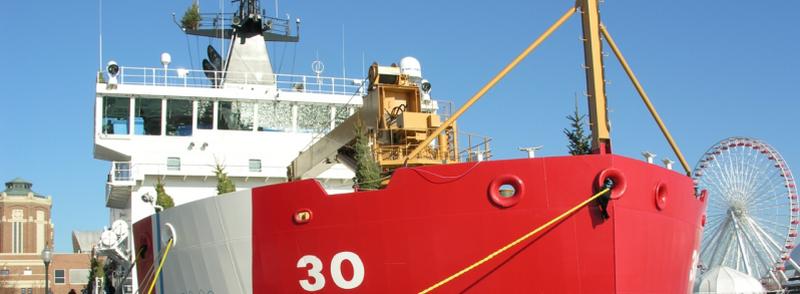 Every year, the Christmas Ship, with the support of the US Coast Guard and volunteer groups, delivers Christmas trees to families in need in Chicago’s communities. This year was no exception, but because of the pandemic, it was a bit different.
Every year, the Christmas Ship, with the support of the US Coast Guard and volunteer groups, delivers Christmas trees to families in need in Chicago’s communities. This year was no exception, but because of the pandemic, it was a bit different.
In past years, the USCG Cutter Mackinaw delivered trees to the Navy pier where volunteers, including Sea Cadets, Venture Crews, Sea Scouts, and Young Marines, off-loaded the trees and loaded them into trucks to be distributed to more than one thousand deserving families.
This year, the Navy Pier is closed to the public and volunteers could not get to the cutter. Nevertheless, in early December, the Cutter Mackinaw arrived with 1,200 Christmas trees. Taking up the challenge, the cutter’s crew offloaded the trees and packaged and loaded them to be delivered. More than a half dozen community groups helped deliver the trees to Chicago-area families.

A view of the A68a iceberg from a Royal Air Force reconnaissance plane near South Georgia Island on Nov. 18. Image: UK Ministry of Defence
In November we posted that the world’s largest iceberg, dubbed A68a, was drifting on a collision course with the island of South Georgia. The iceberg calved from Antarctica’s Larsen C ice-shelf in 2017. The berg weighed roughly one trillion tons and measured 4,200 sq km, or almost the size of the state of Delaware. The fear is that the iceberg might run aground on the sloping seabed around South Georgia, threatening wildlife, particularly penguins and seals.
It now appears that that the massive iceberg is breaking up.
